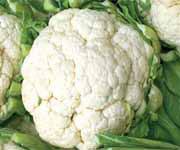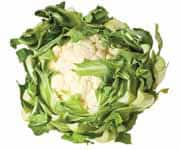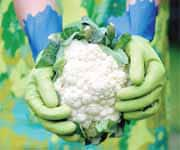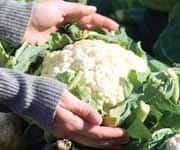Life Extension Magazine®
While broccoli is the most well-known member of the cruciferous vegetable family, evidence is showing that cauliflower has important broad-spectrum health benefits as well. With its bioactive compounds, glucosinolates, and indole-3- carbinol,1 cauliflower shows great promise in providing substantial protection against cardiovascular disease, cancer, diabetes, and rheumatoid arthritis.
Cancer Protection

Phytochemicals are plant compounds that exhibit potent anti-inflammatory, antioxidant, and anti-proliferative properties, making them ideal cancer fighters.2 Cauliflower contains a high concentration of a class of phytochemicals known as glucosinolates, which are metabolized into isothiocyanates.1
A recent study published in the Journal of Medicinal Chemistry sheds light on how isothiocyanates in cauliflower exert their anti-cancer activity.3 Normal cells contain gene p53, which help suppress cancer cell growth. However, if a mutation in gene p53 occurs, it can have the opposite effect which allows abnormal cell division that leads to the formation of cancer. Researchers have discovered that isothiocyanates effectively bind to this defective protein and remove it from the cell, thereby restoring the normal function of gene p53 in blocking cancer cell growth.3
Other research shows that the isothiocyanate sulforaphane combats cancer through different mechanisms. It significantly induces Phase II liver enzymes, which detoxify and neutralize cancer causing agents.4 Additionally, sulforaphane also works by inhibiting a group of enzymes that alter gene expression and produce proteins involved in cancer initiation.5
These multiple modes of action help explain the strong protective effect of cauliflower consumption against various forms of cancer. In one such study reported in the Journal of the National Cancer Institute, consuming more than one serving of cauliflower a day produced a 61% reduction in lung cancer risk.6 Another study showed that just one serving of cauliflower a week was associated with a 27% lower risk of bladder cancer.7
Italian scientists compared cruciferous vegetable intake, including cauliflower, among individuals with and without several common cancers. The results revealed that those who ate cruciferous vegetables at least once a week slashed their risk of oral, colorectal, and breast cancers by 17%, as well as esophagus and kidney cancers by 28% and 32%, respectively.8

Improving Cardiovascular Health
In a study published in the American Journal of Clinical Nutrition, a high intake of cruciferous vegetables like cauliflower reduced the risk of dying from cardiovascular disease by 31%.1 A growing body of evidence indicates that several diverse compounds in cauliflower might be responsible for this cardioprotective effect.9
While the content of cholesterol in LDL particles has been the standard for assessing cardiovascular risk, research indicates that the number of LDL particles is a stronger predictor for developing atherosclerosis and future vascular events including heart attack and stroke.10 Since each LDL particle contains one apolipoprotein (apoB), apoB provides a direct count of the number of LDL particles in circulation. Therefore, reducing apoB leads to a lower LDL particle number and reduced heart disease risk.10
Scientists at the University of Hawaii at Manoa investigated the impact of indole-3-carbinol (I3C), a compound found in large amounts in cauliflower, on apoB secretion in cultured liver cells.11 After exposing the liver cells to I3C, they observed a 56% reduction in apoB secretion that resulted from a decline in the creation of triglycerides and cholesterol esters in the cells, thereby improving heart health.

Cauliflower-rich I3C has also demonstrated the ability to improve platelet function. In a study published in Phytotherapy Research, indole-3-carbinol was shown to significantly inhibit platelet aggregation (stickiness) that can induce a blood clot and cause heart attack or stroke.12
Another cardiovascular benefit of cauliflower relates to its high fiber content, which might have a protective effect against high levels of C-reactive protein, an inflammatory marker associated with predicting cardiovascular disease risk. Researchers examined the relationship between dietary fiber intake and C-reactive protein levels in more than 3,900 men and women aged 20 and older. After adjusting for confounding factors such as age, gender, physical activity and BMI, those with the highest fiber intake had a 51% lower risk for elevated C-reactive protein levels compared with those with the lowest intakes.13
Furthermore, cauliflower is an excellent source of folate and vitamin B6 that might lessen the likelihood of a heart attack. In a study comparing the intake of both vitamins in 507 first time heart attack patients with 478 controls, researchers concluded those who consumed the highest intake of folate and vitamin B6 reduced their heart attack risk by 44% and 66%.14
Selecting and Storing Cauliflower
- Cauliflower is freshest during the growing season from December through March.
- Pick cauliflower that has a full, creamy white head and tight bud clusters.
- Avoid cauliflower with the appearance of small brown spots.
- Place uncooked cauliflower with stem side down in plastic bag and store in refrigerator for up to a week.
Defending Against Diabetes

In recent years, scientists have begun to unravel the role of inflammation in the onset of type II diabetes. They have discovered that chronic inflammation induces insulin resistance, which in turn disrupts normal glucose tolerance and eventually leads to the development of type II diabetes.15 Strong evidence indicates that eating vitamin C rich foods like cauliflower can help modulate inflammation and reduce the risk for the disease. In one study, English researchers found a strong association between blood levels of vitamin C and diabetes risk, with the highest plasma levels of the vitamin reducing diabetes risk by a remarkable 62% in over 21,800 men and women aged 40 to 75 over a 12-year period.16
As a rich source of potassium, cauliflower might help regulate glucose metabolism. Potassium is required by the beta cells in the pancreas to "sense" elevated blood sugar levels and respond appropriately by secreting the hormone insulin. However, in people with low levels of potassium, beta cells have decreased sensitivity to increased blood glucose levels and as a result reduce insulin output.17 Over time, this impairs glucose tolerance and increases diabetes risk. This was supported in a study published in the journal Archives of Internal Medicine in which people with low potassium blood levels had a 64% greater risk for type II diabetes.18
Rheumatoid Arthritis Prevention
Regular consumption of cauliflower might decrease the risk of rheumatoid arthritis, an autoimmune inflammatory disease that targets and damages joints in the body. In research published in the American Journal of Epidemiology, greater than three servings of cauliflower a month was linked to a 17% lower risk of the condition after controlling for confounding factors including smoking, age, tea consumption, and total calorie intake.19
Summary
Cauliflower contains a wealth of fiber and choline, along with powerful phytochemical compounds indole-3-carbinol and isothiocyanates. These health promoting nutrients make incorporating cauliflower into your daily diet a smart strategy to protect against heart disease, cancer, diabetes, and rheumatoid arthritis.
If you have any questions on the scientific content of this article, please call a Life Extension® Wellness Specialist at 1-866-864-3027.
Raw Cauliflower Nutritional Facts, One Cup
 |
| Nutrients | Amount | DV(%) |
| Vitamin C | 46.4 mg | 77% |
| Vitamin K | 16.0 mcg | 20% |
| Folate | 57.0 mcg | 14% |
| Vitamin B6 | 0.2 mg | 11% |
| Fiber | 2.5 g | 10% |
| Potassium | 303.0 mg | 9% |
| Manganese | 0.2 mg | 8% |
| Vitamin B5 | 0.7 mg | 7% |
References
1. Available at: http://www.whfoods.com/genpage.php?tname=foodspice&dbid=13 Accessed October 18, 2012.
2. Lee JH, Khor TO, Shu L, Su ZY, Fuentes F, Kong AN. Dietary phytochemicals and cancer prevention: Nrf2 signaling, epigenetics, and cell death mechanisms in blocking cancer initiation and progression. Pharmacol Ther. 2012 Oct 3. [Epub ahead of print]
3. Wang X, Di Pasqua AJ, Govind S, et al. Selective depletion of mutant p53 by cancer hemopreventive isothiocyanates and their structure-activity relationships. J Med Chem. 2011 Jan;54(3): 809-16.
4. Brooks JD, Paton VG, Vidanes G. Potent induction of phase 2 enzymes in human prostate cancer cells by sulforaphane. Cancer Epidemiol Biomarkers Prev. 2001 Sept;10(9):949-54.
5. Clarke JD, Hsu A, Yu Z, Dashwood RH, Ho E. Differential effects of sulforaphane on histone deacetylases, cell cycle arrest and apoptosis in normal prostate cells versus hyperplastic and cancerous prostate cells. Mol Nutr Food Res. 2011 Jul;55(7):999-1009.
6. Feskanich D, Ziegler RG, Michaud DS, et al. Prospective study of fruit and vegetable consumption and risk of lung cancer among men and women. J Natl Cancer Inst. 2000; 92(22):1812-23.
7. Michaud DS, Spiegelman D, Clinton SK, et al. Fruit and vegetable intake and incidience of bladder cancer in a male prospective cohort. J Natl Cancer Inst. 1999;91(7):605-13.
8. Bosetti C, Filomeno M, Riso P, et al. Cruciferous vegetables and cancer risk in a network of case-control studies. Annals of Oncology. 2011 Dec;23: 2198-203.
9. Zhang X, Shu XO, Xiang YB, et al. Cruciferous vegetable consumption is associated with a reduced risk of total and cardiovascular disease mortality. Am J Clin Nutr.2011 Jul;94(1):240-6.
10. Barter PJ, Ballantyne CM, Carmena R, et al. Apo B versus cholesterol in estimating cardiovascular disease risk and guiding therapy: report of the thirty person/ten-country panel. J Intern Med. 2006 Marc;259(3):247-58.
11. Maiyoh GK, Kuh JE, Casaschi A, Theriault AG. Cruciferous indole-3-carbinol inhibits apolipoprotein B secretion in HepG2 cells. J Nutr. 2007 Oct;137(10):2185-9.
12. Park MK, Rhee YH, Lee HJ, et al. Antiplatelet and antithrombotic activity of indole-3-carbinol in vitro and in vivo. Phytotherapy Res. 2008 Jan;22(1):58-64.
13. Ajani UA, Ford ES, Mokdad AH. Dietary fiber and C-reactive protein: findings from national health and nutrition examination survey data. J Nutr. 2004 May;134(5):1181-5.
14. Tavani A, Pelucchi C, Parpinel M, Negri E, La Vecchia C. Folate and vitamin B(6) and risk of acute myocardial infarction in Italy. Eur J Clin Nutr. 2004 Sept;58(9):1266-72.
15. Shoelson SE, Lee J, Goldfine AB. Inflammation and insulin resistance. J Clin Invest.2006;116(7):1793-801.
16. Harding AH, Wareham NJ, Bingham SA, et al. Plasma vitamin C level, fruit and vegetable consumption, and the onset type 2 diabetes mellitus: the European prospective investigation of cancer—Norfolk prospective study. Arch Intern Med. 2008 Jul;168(14):1493-9.
17. Chatterjee R, Yeh HC, Edelman D, Brancati F. Potassium and risk of type 2 diabetes. Expert Rev Endocrinol Metab.2011 Sept;6(5):665-72.
18. Chatterjee R, Yeh HC, Shafi T, et al. Serum and dietary potassium and risk of incident type 2 diabetes mellitus: the atherosclerosis risk in communities (ARIC) study. Arch Intern Med. 2010 Oct;170(19):1745-51.
19. Cerhan JR, Saag KG, Merlino LA, Mikuls TR, Criswell LA. Antioxidant micronutrients and risk of rheumatoid arthritis in a cohort in older women. Am J Epidemiol. 2003 Feb;157(4):345-54.
20. Available at: http://nutritiondata.self.com/facts/vegetables-and-vegetable-products/2390/2 Accessed October 20, 2012.

